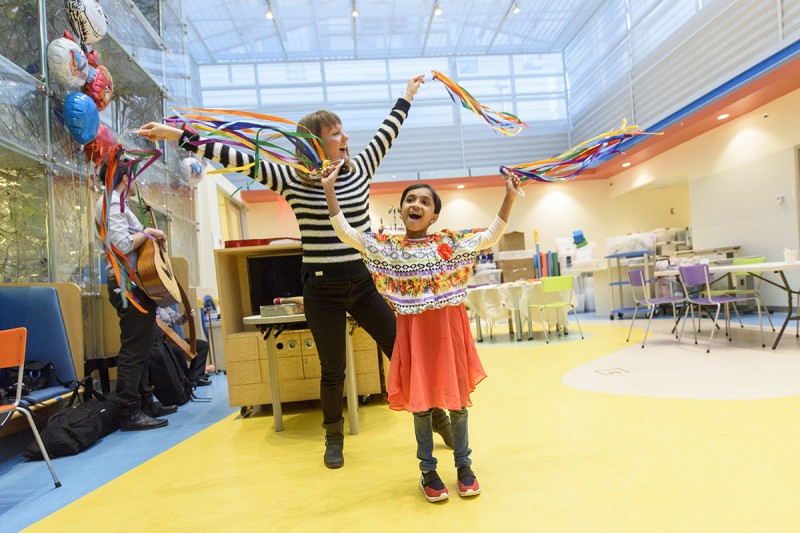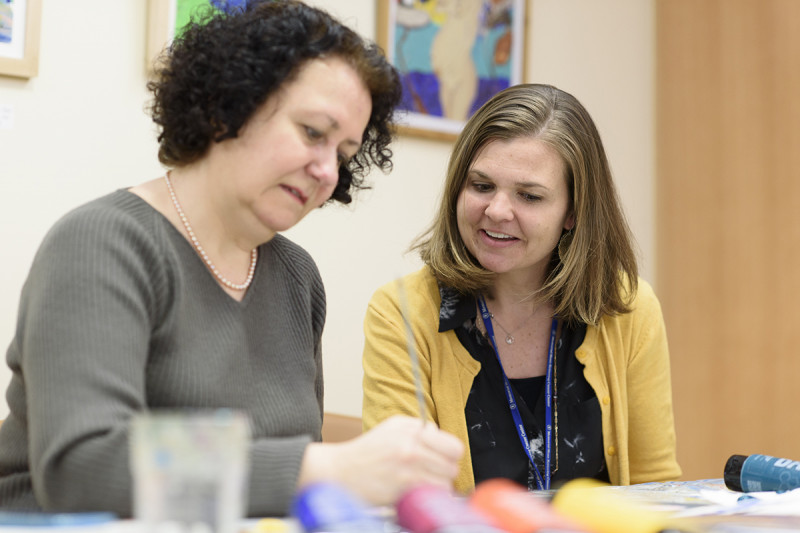
"Moments when I help patients find their sparkle again are the best," says MSK dance and movement therapist Jenn Whitley.
Art has a proven, powerful effect on the healing process. At Memorial Sloan Kettering, patients, family members, and friends can incorporate visual arts, music, and dance into a care plan with the help of skilled therapists. Meet three professionals who use the power of art to aid in restoration and recovery.
A dance therapist is a psychotherapist who uses movement and dance as language to communicate.
Jenn Whitley, Dance and Movement Therapist
MSK Department of Pediatrics
Years at MSK: 6
Making space: “Dance therapy is about connecting a person to his or her body. Sometimes there really are no words to express a feeling, but moving through a situation can provide information. Movement tells a story about where people have been, who they are, where they are going, and how they might get there.”
Lifelong passion: “I began dancing when I was six. I remember the first time I went to a dance recital. I will never forget the excitement I felt while watching the girls on stage. I was a shy child, but on my first day of dance class, I didn’t feel shy. I felt proud. I walked right into the studio in my small ballet shoes and got to work. I have not stopped dancing since.”
Building a career: “Before joining MSK, I was a fundraiser for the Andrea Rizzo Foundation, which supports the dance and movement therapy program in MSK’s Department of Pediatrics. Fundraising and educating others about the foundation’s work is what led me to this profession.”
Spontaneous studios: “Most dance therapy sessions for children and young adults occur at the bedside. But occasionally, a spontaneous dance and movement therapy group will bubble up on an outpatient or inpatient floor. We have just started a new dance and movement group in the patient recreation area.”
All in a day’s work: “I can go from celebrating a clear scan to supporting a family who has received news of disease progression. We might start a dance party in the waiting room with scarves and rainbow streamers, or I might provide support using pain management tools, such as gentle swaying movements. Children and young adults in isolation are usually a high priority since they are limited on socialization, movement, and engagement with the outside world. I usually see seven to nine patients each day.”
Perks of the job: “That moment when you feel you’ve connected with a person and watch him or her become more vibrant. Moments when I help patients find their sparkle again are the best.”
Memorable moment: “A teenage patient had surgery to remove a tumor in her leg. She was feeling discouraged about how long it would be until she could walk again. I wanted to support her journey. Using a technique called body scanning, I verbally led her on a guided journey inside her body to mentally, emotionally, and physically reconnect with herself, particularly her leg. Through our work, she was able to shift her thoughts from sadness, anger, and frustration to hope, calmness, and movement toward healing.”
An art therapist supports people in connecting to their own creative process. This leads to insight, healing, and community.
Deborah Rice, Art Therapist
Evelyn H. Lauder Breast Center
Years at MSK: 2
Her role: “I work with adults in a drop-in art therapy studio at the Evelyn H. Lauder Breast Center. The studio allows people to explore materials and their creative process at their own pace while also connecting to those with shared experiences in a community setting.”
Art from the heart: “Materials available include watercolors, acrylic paint, pastels, and found objects. I asked a patient to explain what kind of art we do, and she replied, ‘Art from the heart!’ ”
The path to her position: “I completed my bachelor’s degree in psychology and fine arts. During that time I worked with a young child who had autism. Witnessing the power of creativity and nonverbal expression led me to creative arts therapy. I completed a master’s degree at Pratt Institute in Brooklyn, where I am now an adjunct professor. The focus of my study was more on the experiences evoked from creating rather than on the actual finished product.”
A day in the life: “I set up the studio and then greet people as they flow in. Some come in the morning and stay for the duration of the day. Some come between appointments or go to the studio instead of spending time in the waiting area. I usually ask people to set an intention before they begin creating. I then support them as they decide on materials and the subject, if there is one. The art making typically concludes with me asking them to reflect on their work and experience. Sometimes this is done individually, while other times we do it as a group.”
How art influences healing: “Nonverbal expression is extremely important and powerful. It is fundamental to our creativity and unconscious. It allows people to convey feelings, experiences, and emotions that may be difficult to access or express with words. It also provides an outlet to focus on something external and tactile. Art can increase self-esteem and a person’s sense of hope, and decrease isolation, anxiety, and fear. The process can provide a sense of control, as well as allow people the freedom to let go.”
Memorable moment: “One woman I met was really struggling with the loss of her hair due to chemotherapy. She shared with me that she had saved her hair and wondered if she could do something with it. She ended up using it to paint with and also created a self-portrait that included pieces of her hair.”
Rewards of the job: “Seeing people connect and share personal experiences, and being a witness to people taking risks and being vulnerable.”

Karen Popkin plays guitar for people at the bedside.
A music therapist builds therapeutic relationships with people through music. Music therapy can help them improve their health and functioning.
Karen Popkin, Music Therapist
Memorial Hospital
Years at MSK: 12
The role of a music therapist: “We provide music-based meditation and help our patients create music together. No two sessions are alike. Sometimes our patients need to talk to us, and others simply sit back and listen.”
Her repertoire: “If a person wants to hear a specific song, we will learn it. Quite a few of the songs in my book are there because someone had a strong affinity for it.”
A day in the life: “Much of the time, I provide bedside visits, but I also have the great privilege of co-leading a weekly group with a dance and movement therapist for children having treatment.”
The training: “I earned my master of arts in music therapy from New York University. In addition to meeting national requirements for instrumental and vocal skills, my training included psychology and counseling courses, along with internships in various healthcare settings.”
How music heals: “Live music can be a lifeline to a more whole life. By refocusing attention on music, people can express themselves, learn something new, or simply let the sounds wash over them and bring relief.”
Memorable moment: “The other day, a patient teared up when I started to play guitar. She said, ‘This is the first human thing I’ve had since my surgery.’ ”
Perks of the job: “When a connection happens through music. Sometimes it is a reawakened bond between the person and a loved one. Other times someone rediscovers inner resources and strength. Being present for these moments is incredibly rewarding.”

